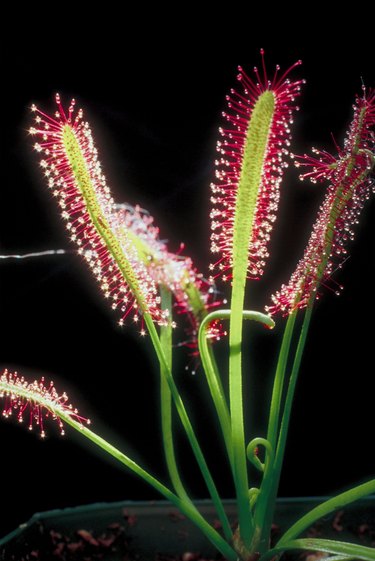
Insectivorous, or carnivorous, plants trap insects and digest them as food. Like other plants, they also use chlorophyll and sunlight to produce food through photosynthesis. Most insectivorous plants require moist, acidic soil and often grow well in indoor fish tanks or terrariums. Cover the tank to preserve humidity and place it in a sunny, east- or west-facing window or near a fluorescent light.
Bromeliads
Video of the Day
The large Bromeliad family includes South American plants which hold water in cupped leaves, or tanks, that act as traps for insect prey. Catopsis berteronania is a tank bromeliad which grows without soil on tree branches in full sun or partial shade. Slippery powder on its leaves reflects ultraviolet light. Insects become disoriented, bump into the plant and slip into the tank. Brocchinia reducta prefers infertile soil in full sun. The tank attracts insects with a fragrance, and the insects slip on the same type of powder and fall into the tank.
Video of the Day
Butterwort
Butterwort grows in cold climates in Europe, Siberia and North America. This perennial prefers alkaline soil in wet, rocky areas. Its broad, 3-inch-long leaves curl inward and form a rosette. In the spring and summer, each flower stalk produces a single purple flower with a white center. Glands on the upper leaf surface produce a sticky, slippery substance which traps insect prey. As the prey struggles, the leaves curl inward and the glands secrete more of this sticky substance. Other glands produce enzymes which digest the insect.
Pitcher Plant
Pitcher plants grow wild in sunny or partially shaded wetlands of the eastern United States and Canada. The plant forms a rosette of pitcher-shaped green leaves with purplish veins. After the red flowers bloom in the spring, the plant produces more leaves. Each pitcher, which contains water, has a slippery coating and downward-facing hairs. A sweet fragrance attracts insects, which slip into the pitcher. The hairs trap the prey, the insect drowns, and digestive enzymes draw nutrients from the food.
Sundew
Sundew plants grow outdoors in warm wetlands and indoors as houseplants. Like other insectivorous plants, sundews have a low, leafy rosette. Among the more than 100 sundew species, the leaves range in shape from broad and flat to fine and narrow. Small, red hairs on the leaves produce clear, sticky droplets which trap insect prey. As the insect struggles, the hairs pull the insect toward the plant's digestive juices.
Venus Flytrap
The Venus flytrap grows indoors or in wetlands as far north as New Jersey and as far south as Florida. Its fringed, clamshell-shaped leaves form flattened rosettes which measure up to 6 inches wide. White flowers bloom in the spring. The leaves remain open, revealing a green, yellow or reddish pink lining. Nectar attracts insects to the leaves, which contain trigger hairs. When an insect touches the hairs, the trap snaps shut and the leaves secrete digestive juices as the prey struggle to escape. According to Iowa State University Extension, the trap remains closed for about 10 days as the plant digests the insect's soft tissue. The "clamshell" reopens to attract more prey.
- Iowa State University Extension: Carnivorous Plants; Richard J. Dauron; December 1998
- University of Florida IFAS Extension: Carnivorous Bromeliads; J.H. Frank; October 1996
- University of Illinois Extension: Pitcher Plants – Unique Garden Additions; Sandra Mason; August 2007
- Clemson University Cooperative Extension Service: Bromeliads; Karen Russ; October 2007
- Michigan State University Extension: Pinguicula Vulgaris – Butterwort; Michael R. Penskar and J.A. Hansen; 2009
- Floridata: Venus Flytrap; Steve Christman; October 2003